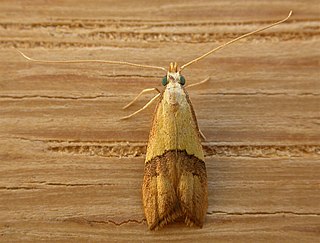John Hartley Durrant was an English entomologist who specialised in Lepidoptera.

Crocanthes prasinopis is a species of moth of the family Lecithoceridae. It is found in most Australia and New Guinea.

Crocanthes glycina is a species of moth of the family Lecithoceridae. It is found in Australia, where it has been recorded from Victoria, the Australian Capital Territory and Tasmania.

Crocanthes is a genus of moths in the family Lecithoceridae.
Sphenocrates aulodocha is a moth in the family Gelechiidae. It was described by Edward Meyrick in 1918. It is found on New Guinea.
Lecithocera deloma is a moth in the family Lecithoceridae. It was described by John Hartley Durrant in 1915. It is found on New Guinea.
Lecithocera strigosa is a moth in the family Lecithoceridae. It was described by John Hartley Durrant in 1915. It is found on New Guinea.
Crocanthes diula is a moth in the family Lecithoceridae. It was described by Edward Meyrick in 1904. It is found in Australia, where it has been recorded from Queensland.
Crocanthes doliopa is a moth in the family Lecithoceridae. It was described by Edward Meyrick in 1921. It is found in Australia, where it has been recorded from Queensland.
Crocanthes halurga is a moth in the family Lecithoceridae. It was described by Edward Meyrick in 1904. It is found in Australia, where it has been recorded from Queensland.
Crocanthes perigrapta is a moth in the family Lecithoceridae. It was described by Edward Meyrick in 1904. It is found in Australia, where it has been recorded from Queensland, New South Wales and South Australia.
Crocanthes acroxantha is a moth in the family Lecithoceridae. It was described by Oswald Bertram Lower in 1896. It is found in Australia, where it has been recorded from Queensland.
Crocanthes pancala is a moth in the family Lecithoceridae. It was described by Turner in 1919. It is found in Australia, where it has been recorded from Queensland.
Crocanthes eurypyra is a moth in the family Lecithoceridae. It was described by Edward Meyrick in 1918. It is found on New Guinea.
Crocanthes gelastis is a moth in the family Lecithoceridae. It was described by Edward Meyrick in 1918. It is found on New Guinea.
Crocanthes sceletopa is a moth in the family Lecithoceridae. It was described by Edward Meyrick in 1910. It is found on the Maluku Islands in Indonesia.
Crocanthes monodesma is a moth in the family Lecithoceridae. It was described by Edward Meyrick in 1931. It is found on New Guinea. Lepidoptera and Some Other Life Forms gives this name as a synonym of Crocanthes fallaxDurrant, 1915.
Crocanthes celema is a moth in the family Lecithoceridae. It was described by John Hartley Durrant in 1915. It is found on New Guinea.
Crocanthes fallax is a moth in the family Lecithoceridae. It was described by John Hartley Durrant in 1915. It is found on New Guinea.
Bursadella timetica is a moth in the family Immidae. It was described by John Hartley Durrant in 1915. It is found on New Guinea.

